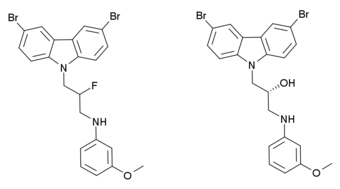P7C3
 | |
| Identifiers | |
|---|---|
| |
| PubChem (CID) | 2836187 |
| ChemSpider |
2113543 |
| ChEMBL |
CHEMBL2442630 |
| Chemical and physical data | |
| Formula | C21H18Br2N2O |
| Molar mass | 474.188 g/mol |
| 3D model (Jmol) | Interactive image |
| |
| |
| | |
P7C3 is a drug related to latrepirdine (dimebon), which has neuroprotective and proneurogenic effects, and may be potentially useful for the treatment of Alzheimer's disease and similar neurodegenerative disorders. The precise mechanism of action through which these effects are exerted remains unclear as of 2010, but the pharmacological effects of P7C3 in vitro resemble those of endogenous proneurogenic peptides such as fibroblast growth factor 1, and the proneurogenic activity of P7C3 was around thirty times that of dimebon when they were compared side by side in mice. P7C3 was chosen for further animal studies on the basis of favourable pharmacokinetic factors, such as its high oral bioavailability and long duration of action, but several other related compounds showed similar activity such as the more potent fluorinated analogue P7C3A20 which is up to ten times stronger again, and the methoxy analogue P7C3-OMe, for which it was determined that the (R) enantiomer is the active form.[1]

References
- ↑ Pieper AA, Xie S, Capota E, Estill SJ, Zhong J, Long JM, Becker GL, Huntington P, Goldman SE, Shen CH, Capota M, Britt JK, Kotti T, Ure K, Brat DJ, Williams NS, MacMillan KS, Naidoo J, Melito L, Hsieh J, De Brabander J, Ready JM, McKnight SL (July 2010). "Discovery of a proneurogenic, neuroprotective chemical". Cell. 142 (1): 39–51. doi:10.1016/j.cell.2010.06.018. PMC 2930815
 . PMID 20603013.
. PMID 20603013.